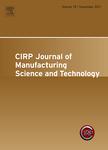版权所有:内蒙古大学图书馆 技术提供:维普资讯• 智图
内蒙古自治区呼和浩特市赛罕区大学西街235号 邮编: 010021

作者机构:Department of Mechanical Engineering Indian Institute of Technology Palakkad Kerala 678623 India Mikrotools Private Limited Jalan Bukit Merah 159456 Singapore Division of Materials and Manufacturing Science Graduate School of Engineering Osaka University Osaka565-0871 Japan
出 版 物:《CIRP Journal of Manufacturing Science and Technology》 (CIRP J. Manuf. Sci. Technol.)
年 卷 期:2025年第58卷
页 面:1-19页
核心收录:
学科分类:080602[工学-钢铁冶金] 1201[管理学-管理科学与工程(可授管理学、工学学位)] 0819[工学-矿业工程] 0806[工学-冶金工程] 0817[工学-化学工程与技术] 08[工学] 0802[工学-机械工程] 0803[工学-光学工程] 0812[工学-计算机科学与技术(可授工学、理学学位)] 080201[工学-机械制造及其自动化]
基 金:The authors would like to acknowledge the support received for the project from Industry Collaboration and Sponsored Research (ICSR) section of IIT Palakkad (Ref No: IITPKD/ICSR/REC/2023/109). The authors are also grateful for the consistent support received from the staff in Central Instrumentation Facility (CIF) and Design & Manufacturing (D & M) Laboratory at IIT Palakkad India
摘 要:Additive Manufacturing (AM) is a near net shape fabrication technology offering exceptional design freedom for complex part production. However, the inadequate surface quality and poorly generated micro-features adversely affect the functional performance of metal AM parts thereby restricting the direct adoption in biomedical implantation applications. Ultra-precision diamond turning (UPDT) can be regarded as a possible solution to overcome the aforementioned challenges in metal AM. However, the machinability of metal AM parts at ultra-precision level is highly sensitive to the material specific attributes and microstructure generated by the thermal characteristics of the process. In light of this, the present study follows a novel direction by investigating the dependence of distinct material characteristics imparted by two different AM powder melting sources on the ultra-precision post-treatment performance. Experiments were conducted on laser and electron beam printed beta-Ti alloy (Ti-15Mo-5Zr-3Al) which has potential importance in biomedical applications. The results demonstrate that the microstructural variations in respective samples affect the process performance and final surface integrity. The samples printed using laser powder bed fusion (LPBF) achieved a final surface finish (Sa) of ∼66.3 nm after UPDT relative to the electron beam powder bed fusion (EPBF) samples (∼104.3 nm). The cutting forces tends to exhibit sharp dip in forces in case of LPBF samples when micro-cutting was done perpendicular to the beam scanning direction. The chip morphology analysis corresponding to the LPBF and EPBF samples substantiates the generation of chips with segmentation/serrations on the free chip surface and parent material adhesion on the tool-chip contact surface. Further, precise microfeature generation was successfully accomplished on both the samples with minimal dimensional deviations on LPBF sample. Thus, the outcomes of the study establish the potential of UPDT